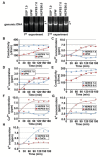Treatment of leptothrix cells with ultrapure water poses a threat to their viability
- PMID: 25634812
- PMCID: PMC4381217
- DOI: 10.3390/biology4010050
Treatment of leptothrix cells with ultrapure water poses a threat to their viability
Abstract
The genus Leptothrix, a type of Fe/Mn-oxidizing bacteria, is characterized by its formation of an extracellular and microtubular sheath. Although almost all sheaths harvested from natural aquatic environments are hollow, a few chained bacterial cells are occasionally seen within some sheaths of young stage. We previously reported that sheaths of Leptothrix sp. strain OUMS1 cultured in artificial media became hollow with aging due to spontaneous autolysis within the sheaths. In this study, we investigated environmental conditions that lead the OUMS1 cells to die. Treatment of the cells with ultrapure water or acidic buffers (pH 6.0) caused autolysis of the cells. Under these conditions, the plasma membrane and cytoplasm of cells were drastically damaged, resulting in leakage of intracellular electrolytes and relaxation of genomic DNA. The autolysis was suppressed by the presence of Ca2+. The hydrolysis of peptidoglycan by the lysozyme treatment similarly caused autolysis of the cells and was suppressed also by the presence of Ca2+. However, it remains unclear whether the acidic pH-dependent autolysis is attributable to damage of peptidoglycan. It was observed that L. discophora strain SP-6 cells also underwent autolysis when suspended in ultrapure water; it is however, uncertain whether this phenomenon is common among other members of the genus Leptothrix.
Figures







Similar articles
-
Abiotic Deposition of Fe Complexes onto Leptothrix Sheaths.Biology (Basel). 2016 Jun 3;5(2):26. doi: 10.3390/biology5020026. Biology (Basel). 2016. PMID: 27271677 Free PMC article.
-
Dissociation and Re-Aggregation of Multicell-Ensheathed Fragments Responsible for Rapid Production of Massive Clumps of Leptothrix Sheaths.Biology (Basel). 2016 Aug 1;5(3):32. doi: 10.3390/biology5030032. Biology (Basel). 2016. PMID: 27490579 Free PMC article.
-
Isolation, Cultural Maintenance, and Taxonomy of a Sheath-Forming Strain of Leptothrix discophora and Characterization of Manganese-Oxidizing Activity Associated with the Sheath.Appl Environ Microbiol. 1992 Dec;58(12):4001-10. doi: 10.1128/aem.58.12.4001-4010.1992. Appl Environ Microbiol. 1992. PMID: 16348826 Free PMC article.
-
A comprehensive review of the control and utilization of aquatic animal products by autolysis-based processes: Mechanism, process, factors, and application.Food Res Int. 2023 Feb;164:112325. doi: 10.1016/j.foodres.2022.112325. Epub 2022 Dec 10. Food Res Int. 2023. PMID: 36737919 Review.
-
Bacterial walls, peptidoglycan hydrolases, autolysins, and autolysis.Microb Drug Resist. 1996 Spring;2(1):95-8. doi: 10.1089/mdr.1996.2.95. Microb Drug Resist. 1996. PMID: 9158729 Review.
Cited by
-
Porous Pellicle Formation of a Filamentous Bacterium, Leptothrix.Appl Environ Microbiol. 2022 Dec 13;88(23):e0134122. doi: 10.1128/aem.01341-22. Epub 2022 Nov 23. Appl Environ Microbiol. 2022. PMID: 36416549 Free PMC article.
-
A Factor Produced by Kaistia sp. 32K Accelerated the Motility of Methylobacterium sp. ME121.Biomolecules. 2020 Apr 16;10(4):618. doi: 10.3390/biom10040618. Biomolecules. 2020. PMID: 32316239 Free PMC article.
-
Abiotic Deposition of Fe Complexes onto Leptothrix Sheaths.Biology (Basel). 2016 Jun 3;5(2):26. doi: 10.3390/biology5020026. Biology (Basel). 2016. PMID: 27271677 Free PMC article.
-
Identification of lthB, a Gene Encoding a Putative Glycosyltransferase Family 8 Protein Required for Leptothrix Sheath Formation.Appl Environ Microbiol. 2023 Apr 26;89(4):e0191922. doi: 10.1128/aem.01919-22. Epub 2023 Mar 23. Appl Environ Microbiol. 2023. PMID: 36951572 Free PMC article.
-
Leptothrix cholodnii Response to Nutrient Limitation.Front Microbiol. 2021 Jun 24;12:691563. doi: 10.3389/fmicb.2021.691563. eCollection 2021. Front Microbiol. 2021. PMID: 34248917 Free PMC article.
References
-
- Suzuki T., Ishihara H., Toyoda K., Shiraishi T., Kunoh H., Takada J. Autolysis of bacterial cells leads to formation of empty sheaths by Leptothrix spp. Minerals. 2013;3:247–257. doi: 10.3390/min3020247. - DOI
-
- Spring S. The general Leptothrix and Sphaerotilus. Prokaryotes. 2006;5:758–777.
LinkOut - more resources
Full Text Sources
Other Literature Sources
Miscellaneous

